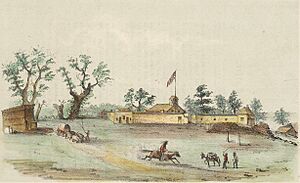New Helvetia facts for kids
New Helvetia (which means "New Switzerland" in Spanish) was a settlement and large ranch in Alta California during the 1800s. It was located where the city of Sacramento is today.
The name "New Helvetia" comes from Switzerland, which was the home country of its founder, John Sutter.
Contents
Starting the Colony of New Helvetia
A Swiss pioneer named John Sutter (born 1803, died 1880) arrived in Alta California in August 1839 with other settlers from Europe and America. He decided to create a place for farming and trading. He built a strong fort called Sutter's Fort and named his new settlement "Nueva Helvetia."
This colony was built where the Sacramento River and American River meet. This spot is now on the eastern edge of downtown Sacramento.
Rancho New Helvetia: A Huge Land Grant
Rancho New Helvetia was a very large piece of land, about 48,839 acres (197.6 square kilometers). The Mexican Governor Juan Bautista Alvarado gave this land grant to John Sutter in 1841.
The rancho covered parts of what are now Sacramento County, Sutter County, and Yuba County, California. It stretched from near Marysville south along the Feather River to where the Sacramento and American rivers meet. This rancho was much bigger than Sutter's first colony.
At the time, most towns and ranches in Mexican Alta California were near the coast. The Californios (people of Spanish or Mexican descent living in California) were worried about people from other countries, especially Americans, moving into their lands. To help protect the area from these newcomers and from Native American groups, Governor Alvarado gave Sutter the largest amount of land allowed by Mexican law. Part of Sutter's job was to encourage more settlers to come. He gave out many smaller pieces of land, but these were more than he actually owned in the end.
How New Helvetia Operated
During the wheat harvest, as many as six hundred Native Americans worked at New Helvetia. Other businesses there included a place to make alcohol, a hat factory, a blanket factory, and a tannery (for making leather). These workers were often recruited by local Native American leaders.
However, the living and working conditions at the fort were very bad. Some people have described it as a form of forced labor. Native Americans who did not cooperate were sometimes punished. Conditions were a bit better for workers who lived in their own nearby villages.
Sutter's settlement also had an army. This army was made up of about 150 foot soldiers and 50 cavalry (soldiers on horseback) from the Miwok and Nisenan tribes, along with some German-speaking officers. This group wore Russian uniforms that Sutter had bought from Fort Ross. This army even marched to the Pueblo of Los Angeles and briefly helped Governor Manuel Micheltorena during a revolt.
The California Gold Rush Begins
In January 1848, a man named James W. Marshall found gold at Sutter's Mill, which was on Sutter's rancho. This discovery started the famous California Gold Rush.
After gold was found, huge numbers of gold-seekers rushed to the area. Sutter's workers left him to search for gold themselves. Soon, people started taking over his land without permission. Because of this, Sutter was forced to give up his businesses at New Helvetia. By 1852, he was bankrupt.
Today, Sutter's Fort is kept as a California State Historic Park, so people can visit and learn about its history.
After California Became a State
After the Mexican–American War, California became part of the United States in 1848. The Treaty of Guadalupe Hidalgo said that the land grants given by Mexico would still be honored.
In 1852, Sutter filed a claim for the 11 square leagues of land that Governor Alvarado had given him in 1841. He also tried to claim an additional 22 square leagues in 1853, saying Governor Manuel Micheltorena had granted it to him and his son in 1845.
The US District Court approved both grants in 1857. However, the United States Attorney General appealed the decision, taking the case to the US Supreme Court. Even though Sutter couldn't find the original papers for his grant, the Supreme Court accepted the 1841 Alvarado grant (Rancho New Helvetia). But they sent the 1845 Micheltorena grant back to the district court. In 1864, the US Supreme Court rejected the 1845 Micheltorena grant. The 11 square league Alvarado grant was officially given to John A. Sutter in 1866.
For 15 years after losing the larger grant, Sutter tried to get money from the United States Congress for his help in settling California. But he didn't get much help.
John Sutter died in 1880 in a hotel in Washington, D.C..
See also
 In Spanish: Nueva Helvetia para niños
In Spanish: Nueva Helvetia para niños


